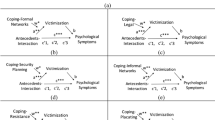Abstract
This study investigated the association between family violence and the attributions made for negative partner behaviors in an Australian context. Three groups of men were classified as physically violent (in counseling), non-physically violent (in counseling), and non-physically violent (in the community). The Relationship Attribution Measure was used to assess the attributional dependent variables of locus, stability, globality, intent, motivation, and blame. Significant differences between violent and nonviolent men on each of the attributional dimensions were found. Physically violent men were more likely than non-physically violent men (counseling) to attribute the negative behavior of their partners to unchangeable, intentional rather than unintentional, selfishly motivated, and blameworthy causes. However, these differences disappeared when marital satisfaction was controlled. The implications of this work for domestic violence intervention programs are discussed, along with a number of methodological issues and directions for future research.
Similar content being viewed by others
REFERENCES
Aldarondo, E., and Straus, M. A. (1994). Screening for physical violence in couple therapy: Methodological, practical and ethical consideration. Family Process 33: 425–439.
Aron, A., Aron, E. N., Tudor, M., and Nelson, G. (1991). Close relationships as including other in the self. J. Person. Soc. Psychol. 60(2): 241–253.
Barling, J., O'Leary, K. D., Jouriles, E. N., Vivian, D., and MacEwen, K. E. (1987). Factor similarity of the conflict tactics scales across samples, spouses and sites: Issues and implications. J. Family Violence 2(1): 37–55.
Bograd, M. (1988). How battered women and abusive men account for domestic violence: Excuses, justification, or explanation? In Hotaling, G. T., Finkelhor, D., Kirkpatrick, J. T., and Straus, M. A. (eds.), Coping with Family Violence: Research and Policy Perspectives, Sage, Newbury Park, CA, pp. 60–70.
Bradbury, T. N., and Fincham, F. D. (1990). Attributions in marriage: Review and critique. Psychol. Bull. 107(1): 3–33.
Bray, J. H., and Maxwell, S. E. (1985). Multivariate Analysis of Variance, Sage. Beverly Hills, CA.
Dodge, K. A., and Coie, J. D. (1987). Social-information processing factors in reactive and proactive aggression in children's peer groups. J. Person. Soc. Psychol. 6: 1146–1158.
Dutton, D. G. (1986). Wife assaulter's explanations for assault: The neutralisation of selfpunishment. Can. J. Behav. Sci. 18: 381–390.
Easteal, P. (1993). Killing the Beloved: Homicide Between Adult Sexual Intimates, Australian Institute of Criminology, Canberra.
Edleson, J. L., and Brygger, M. P. (1986). Gender differences in reporting of battering incidences. Family Relat. 35: 377–382.
Family Violence Professional Education Taskforce (1991). Family violence: Everybody's Business Somebody's Life, The Federation Press, Sydney.
Faulkner, K., and Cogan, R. (1990). Measures of shame and conflict tactics: Effects of questionnaire order. Psychol. Rep. 66(3; Pt 2): 1217–1218.
Ferrante, A., Indermaur, D., Morgan, F., and Harding, H. (1995). Estimating the incidence and prevalence of domestic violence in Western Australia. A report to the Minister for Community Development, Crime Research Centre, University of Western Australia, Perth.
Fincham, F. D. (1985). Attribution processes in distressed and non-distressed couples: 2. Responsibility for marital problems. J. Abnorm. Psychol. 94: 183–190.
Fincham, F. D., and Bradbury, T. N. (1987). Cognitive processes and conflict in close relationships: An attribution-efficacy model. J. Person. Soc. Psychol. 53(6): 1106–1118.
Fincham, F.D., and Bradbury, T. N. (1992). Assessing attributions in marriage: The relationship attribution measure. J. Person. Soc. Psychol. 62(3): 457–468.
Fincham, F. D., and Bradbury, T. N. (1993). Marital satisfaction,depression and attributions: A longitudinal analysis. J. Person. Soc. Psychol. 64(3): 442–452.
Fincham, F. D., Beach, S. R., and Nelson, G. (1987). Attributional processes in distressed and nondistressed couples: 3. Causal and responsibility attributions for spouse behavior. Cognit. Ther. Res. 11(1): 71–86.
Fincham, F. D., Bradbury, T. N., Arias, I., and Byrne, C. A. (1997). Marital violence, marital distress, and attributions. J. Family Psychol. 11(3): 367–372.
Hart, B. J. (1995). Violence against women. Paper presented at the Strategic Planning Workshop, National Institute of Justice, Washington, DC, Mar.
Holtzworth-Munroe, A., and Hutchinson, G. (1993). Attributing negative intent to wife behaviour: The attribution of maritally violent versus non-violent men. J. Abnorm. Psychol. 102(2): 206–211.
Holtzworth-Munroe, A., Jacobson, N. S., Fehrenbach, P. A., and Fruzzetti, A. (1992). Violent married couples' attributions for violent and nonviolent self and partner behaviours. Behav. Assess. 14: 53–64.
Horneffer, K. J., and Fincham, F. D. (1997). Attributional models of depression and marital distress: Erratum. Person. Soc. Psychol. Bull. 23: 439.
Jouriles, E. N., and O'Leary, K. D. (1985). Interspousal reliability of reports of marital violent. J. Consult. Clin. Psychol. 53(3): 419–421.
Kelly, H. H., and Michela, J. L. (1980). Attribution theory and research. Annu. Rev. Psychol. 31: 457–501.
Larsen, J., Hudson, S. M., and Ward, T. (1995). Evaluation of attributional change in a relapse prevention program for child molesters. Behav. Change 12(3): 127–138.
Lussier, S., Sabourin, S., and Wright, J. (1993). On causality, responsibility, and blame in marriage: Validity of the entailment model. J. Family Psychol. 7(3): 322–332.
Pence, E., and Paymar, M. (1986). Power and Control: Tactics of Men Who Batter: An Educational Curriculum, Minnesota Program Development, Duluth.
Prochaska, J. O., DiClemente, C. C., and Norcross, J. C. (1992). In search of how people change. Am. Psychol. 47: 1102–1114.
Resick, P. A., and Reese, D. (1986). Perceptions of family, social, clinical and physical aggression in the home. J. Family Violence 1: 71–83.
Straus, M. A. (1979). Measuring intrafamily conflict and violence: The Conflict Tactics Scales. J. Marriage Family 41(1): 75–88.
Straus, M. A., and Gelles, R. J. (1995). Physical Violence in American Families: Risk factors and Adaptations to Violence in 8,145 Families. Transaction, New Brunswick, NJ.
Tabachnick, B. G., and Fidell, L. S. (1989). Using Multivariate Statistics, 2nd ed., Harper Collins, New York.
U.S. Department of Justice. Bureau of Justice Statistics (1994). Domestic violence: Violence between intimates. On-lines. Available at http://ncjrs.aspensys.com:81/new2/vint.pdf.
Walker, L. (1979). The Battered Woman, Harper & Row, New York.
Author information
Authors and Affiliations
Rights and permissions
About this article
Cite this article
Tonizzo, S., Howells, K., Day, A. et al. Attributions of Negative Partner Behavior by Men Who Physically Abuse Their Partners. Journal of Family Violence 15, 155–167 (2000). https://doi.org/10.1023/A:1007590827696
Issue Date:
DOI: https://doi.org/10.1023/A:1007590827696




